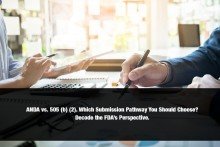In recent years there has been an unprecedented increase in the number of submissions of Abbreviated New Drug Applications (ANDAs) and 505 (b) (2) applications, mainly owing to the spurt in the number of follow-on insulins submitted via the 505 (b) (2) pathway and with a record increase of generic drug applications submitted and approved via the ANDA pathway. While both the submission processes are considerably varying from one another, the US Food and Drug Administration (USFDA), in its recently released draft guidance, elaborately explains the difference between both submission pathways and how should the applications be submitted for the benefit of potential drug developers.
While an ANDA application is an abbreviated application, this is not the case with a 505 (b) (2) application, which contains long reports, including entire investigations, theses as well as reports in full form. A 505 (b) (2) application, can also be referred as a New Drug Application (NDA) is often used to provide detailed observations on the safety and efficacy of the product.
In the case of ANDA applications, filings are made under section 505 (j) of the Federal, Food, Drug and Cosmetic Act. The FDA distinguishes between ANDAs based on whether their safety and efficacy needs to be ascertained. For instance, a duplicate of a Reference Listed Drug (RLD) (which has previously been tried and tested) can utilize an ANDA, whereas a new product, differing vastly from any of the FDA’s RLDs, will require a petitioned ANDA, for which the FDA based on certain criteria determines whether the product requires testing. In addition, if a 505 (b) (2) application is made for a drug that is a duplicate of a listed drug, the FDA is very likely to refuse approval for it.
An ANDA must include sufficient information about the product that is bioequivalent of a Reference Listed Drug (RLD). Consistent with any statutory provisions related to the exclusivity of and patents listed for the RLD, the FDA must thereafter approve it unless there exists insufficient evidence that these criteria are met. The approval of the ANDA is based on the FDA’s finding of safety and efficacy for an RLD and therefore, that the abbreviated application may gain approval without the submission of as much information as an NDA might require in an equivalent situation.
In the case of 505 (b) (2) applications, the applicant has to rely upon the FDA’s findings of safety and efficacy, depending upon to what extent the new application differs from a listed drug. The FDA, can however, refuse approval of duplicate drugs under 505 (b) (2) applications, since they are eligible for approval under section 505 (j) of the FD and C Act.
To conclude, both ANDA and 505 (b) (2) applications serve entirely different purposes, and applicants should determine which pathway they should opt that better suits their requirements before chalking out strategies and choosing submission partners. Learn more on how Freyr catered successful ANDA eCTD Submissions within three weeks.





